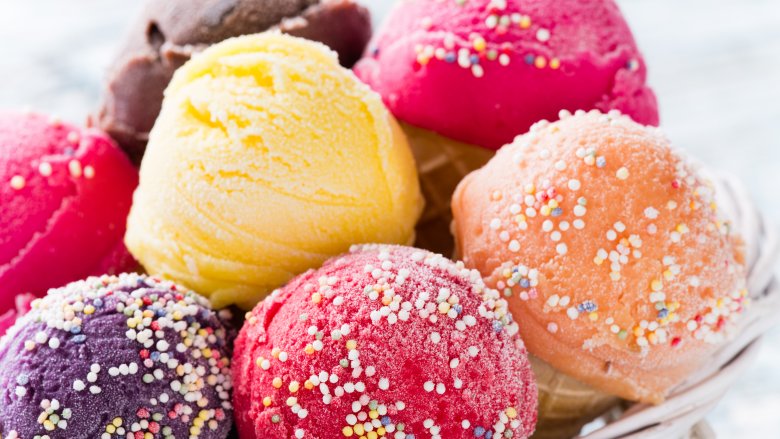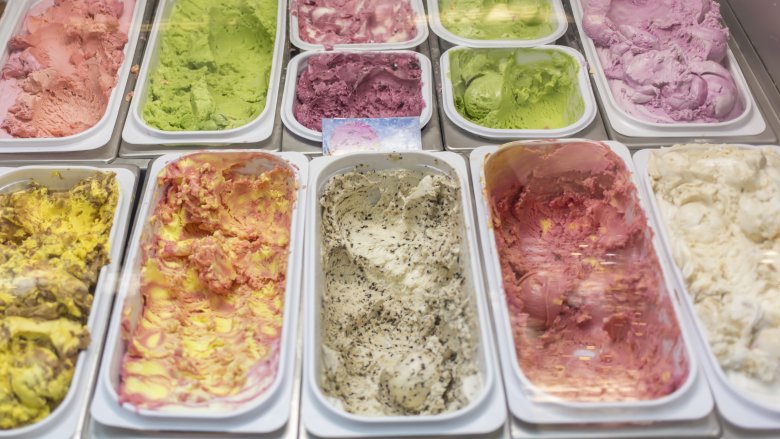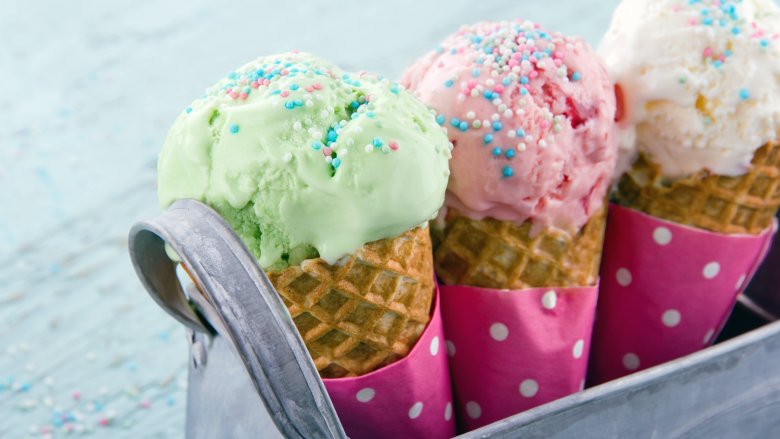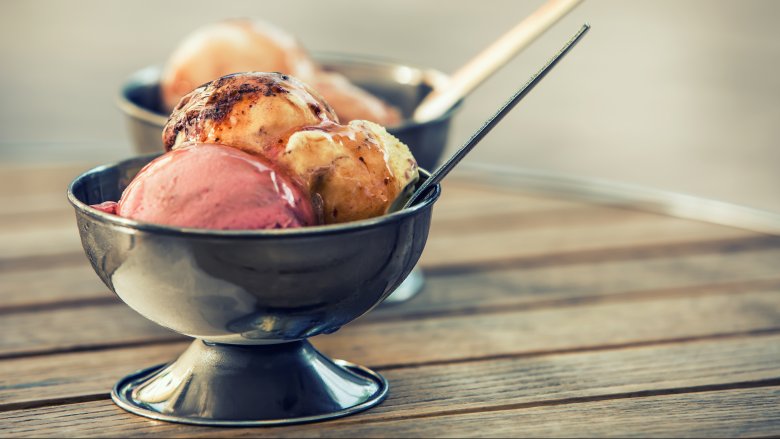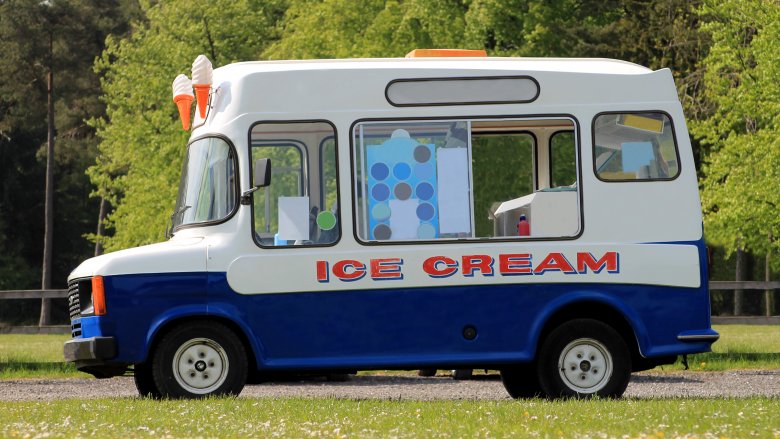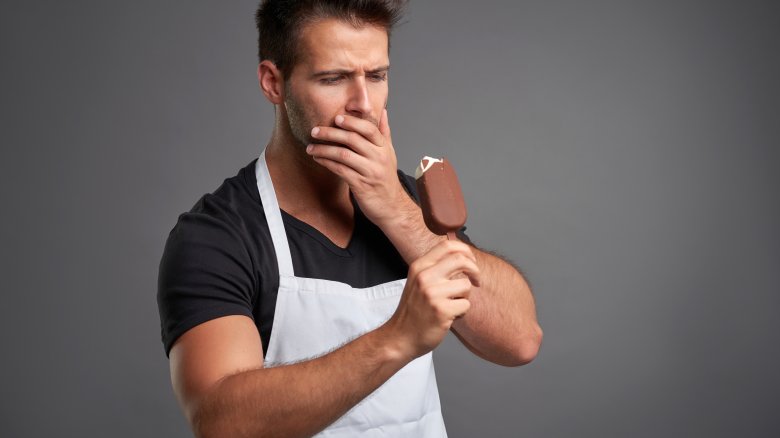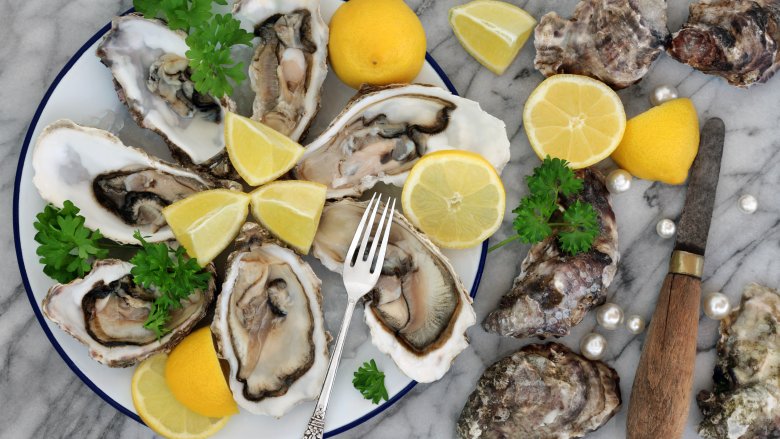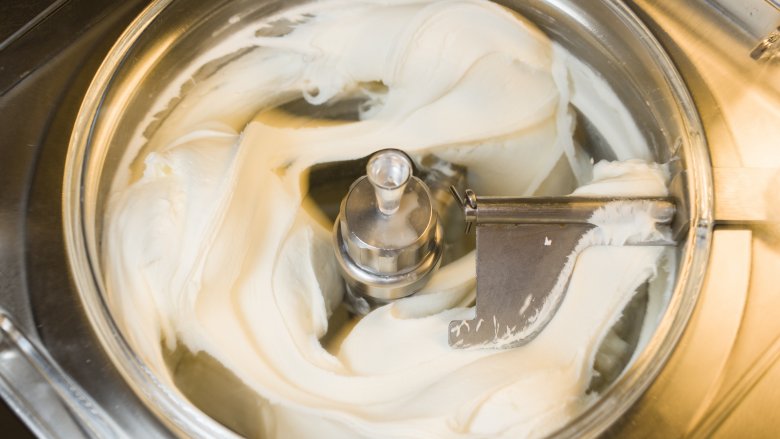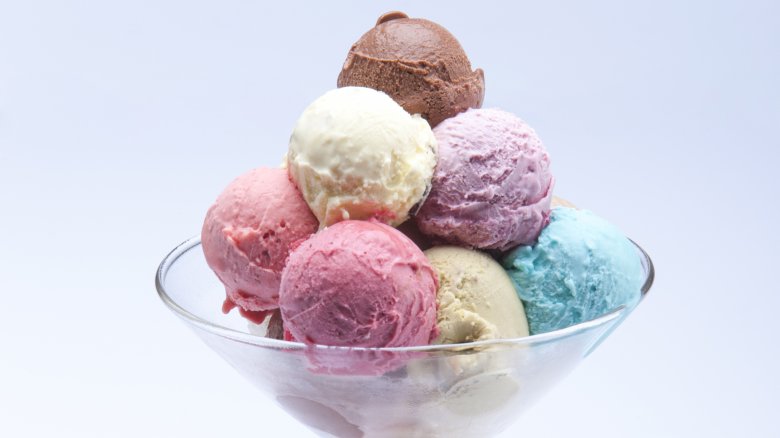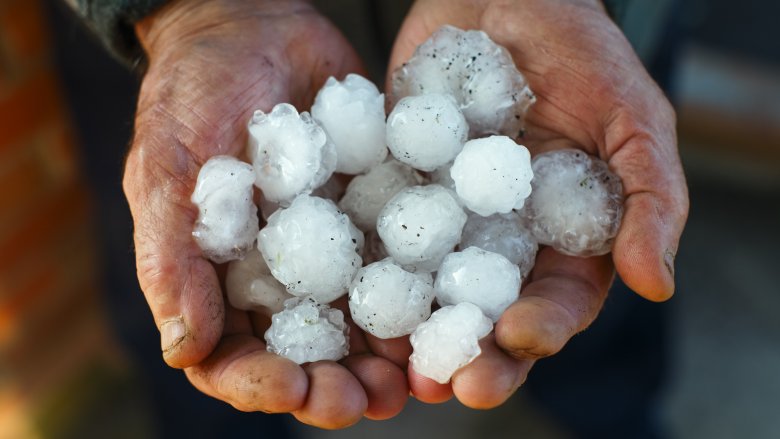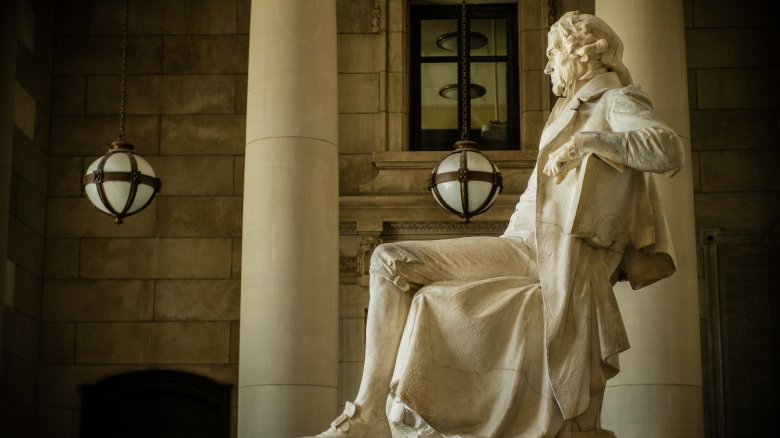The Untold Truth Of Ice Cream
Whether they're into vanilla, rocky road, or mint chocolate chip, most Americans love Ice cream. But have you ever wondered if there's more to this delicious dessert? Even if you've eaten ice cream every day of your life, you likely don't know everything about it. The untold truth of ice cream include tales of American presidents, a cone that could hold enough ice cream to feed over 10,000 people, and even (weirdly), oysters.
We eat a lot of ice cream
I consider ice cream one of my guilty pleasures, so learning that the average American eats 22 pounds of ice cream a year made me breathe a sigh of relief. Now I can indulge with the knowledge that my fellow Americans are also scarfing down this delicious dessert with abandon.
The International Dairy Foods Association reported that "U.S. ice cream companies made more than 872 million gallons of ice cream in 2014." Unsurprisingly, the summer months are the most popular time for eating ice cream and more ice cream is produced in June than in any other month. In 2012, based on credit card transactions, D.C. ate the most ice cream of any state in the US.
Ice cream cones were born out of despiration
In the early 1900s, two unrelated immigrants to America — one Italian and one Syrian — "invented" the ice cream cone a year apart from each other. An Italian named Italo Marchiony, who had immigrated to the US in the late 1800s, was granted an ice cream cone patent in 1903. But that's not when ice cream cones really took off.
At the St. Louis World's Fair, a Syrian named Ernest A. Hamwi was selling zalabis, essentially Syrian waffle treats, when the ice cream seller next to him ran out of dishes. In true entrepreneurial fashion, Hamwi shaped one of his zalabis into a cone and gave it to the ice cream seller. The ice cream seller's predicament became Hamwi's success, and ice cream cones were finally on the map.
Hamwi went on to open the Missouri Cone Company and in the 1950s, The International Association of Ice Cream Manufacturers named him the inventor of the ice cream cone. Other accounts attribute the ice cream cone to different inventors, but one thing's for sure — the St. Louis World Fair did spread the popularity of the cones.
Ice cream sundaes were originally only sold on Sundays
Much like the origin story of ice cream cones, there are multiple accounts of the first ice cream sundaes. All accounts agree on one thing, though — the name ice cream sundae started because they were served on Sundays. In one version of the origin story, a law passed in 1890 prevented the sale of soda water on Sundays in Evanston, Illinois. In response, the soda fountains began selling ice cream sodas without the soda —essentially, ice cream sundaes.
The second version takes place in 1881 in Two Rivers, Wisconsin, when George Hallauer asked soda fountain owner Ed Berners if he would add chocolate syrup to his ice cream. Berner then added it to his regular menu. George Giffy, the owner of the ice cream shop in a nearby town, decided to serve the same thing to his customers, and he only sold it on Sundays.
In the third version, Chester Platt, a drugstore owner in Ithaca, New York, served Reverend John Scott vanilla ice cream with chocolate syrup and a candied cherry on (you guessed it) Sundays.
Ice cream trucks and Good Humor bars have something in common
Harry Burt, the inventor of Good Humor bars, is also credited for masterminding the idea of ice cream trucks. One night in 1920, Burt's son had the idea to combine ice cream and lollipop sticks — thus coming up with one of the best inventions since the ice cream sundae, the Good Humor bar. According to Country Living, he was already delivering ice cream when the Good Humor bar was invented. The ease in which the bars could be eaten gave him the idea to sell them directly to customers on the street.
There's a cure for ice cream headaches
You know that painful brain freeze you get when you eat your ice cream too quickly? Well, Dr. Jorge Serrador, a cardiovascular electronics researcher, actually did a medical study to find out how to cure it. He recruited 13 healthy adult volunteers, had them sip ice cold water, and then monitored the blood flow to their brains.
What they found out is that essentially, your brain tries to protect itself from the change in temperature by flooding blood into the area. If you want to get rid of your ice cream headache, just warm up your palate by drinking warm water or putting your tongue up to your palate.
Apparently, ice cream headaches do have a purpose, and it's not just to get you to eat your ice cream more slowly!
Ice cream can kill you (literally)
Unfortunately, ice cream stories don't all have a sweet ending. According to Country Living, before milk was pasteurized in the late 1800s, ice cream poisonings were a common occurrence. "Newspapers described ice cream poisoning epidemics in which dozens of fair-goers, picnic attendees, and party guests were stricken or killed."
Luckily, ice cream epidemics aren't common today, but they're not gone completely. From January 2010 to January 2015, ten cases of listeria infection broke out in four different states. Three of the patients, all living in Kansas, died of their illnesses. For a long time, no one could figure out where the listeria was coming from. That is, until a team from the South Carolina Department of Health linked the listeria cases with Blue Bell ice cream. Blue Bell later recalled all of its products in Texas and Oklahoma — the states where their factories had been linked to the outbreaks.
There's a recipe for oyster ice cream
The Virginia Housewife, written by Mary Randolph in 1860, included a recipe for oyster ice cream, which basically called for freezing oyster soup. This very brief recipe can be found in between recipes for chocolate ice cream and calf's foot jelly. (And you thought the oyster ice cream sounded gross.)
Much speculation has been given about this oyster ice cream recipe. Was it actually meant to be a dessert? Why did she include it in her recipe book?
In The Virginian Pilot, Lorraine Eaton shared the story of making a batch of oyster ice cream after her 10-year-old daughter brought it up during a family game. She couldn't force herself to eat it, but brought it to work, where it received mixed reviews. "One foodie said she could see it being served as an appetizer, perhaps with some Ritz crackers. Others found it OK. One person emerged from the ladies' room rubbing her tongue with a piece of paper towel. She had nearly thrown up."
I think I'm just going to stick with cookies and cream.
Penn State has an ice cream course
You may not think of ice cream as a subject worthy of a prestigious university, but Penn State thinks differently. Their ice cream creamery, the Berkey Creamery, opened in 1865 and has been serving up delicious ice cream — and science-based research about how to make ice cream — ever since.
The Berkey Creamery website proudly states they're "a world authority on ice cream and dairy manufacturing." They also outline their 12-step ice cream making process, which includes milking a herd of over 200 Holsteins twice daily, and keeping their ice cream mixture at 37 degrees for 24 hours in a special tank.
If you want to learn more about how to make ice cream with science based methods, you can sign up to attend their Ice Cream Short Course, which boasts attendance by Baskin-Robbins, Ben and Jerry's, and Good Humor/Breyers, among others.
The tallest ice cream cone ever was over 10 feet tall
Can you guess where the tallest ice cream cone ever was made? If you guessed Italy, you would have been correct — until 2015. That's when Hennig-Olsen, a Norway-based ice cream company, built their colossal cone, measuring over 10 feet tall. A helicopter airlifted the cone to Kristiansand in Southern Norway, where the gigantic cone, weighing almost a ton, was placed in a special cone holder.
They then filled the huge cone with enough strawberry ice cream to feed 10,800 people two scoops each. The cone also contained 15 gallons of chocolate and 242 pounds of waffle biscuit. Paal Hannig-Olsen, the current owner of Hennig-Olsen, told Guinness World Records, "The atmosphere was fantastic, and it was great to be able to share such a massive ice cream moment with everyone present."
Ice cream is way older than you think
Ice cream has a long and varied history that might go all the way back to the time of Alexander the Great over two thousand years ago — depending on who you ask. Some say the Romans invented it as early as 54-68 BC, when they mixed ice with flavors and then drank it — but that's not much like the ice cream we know. Another account comes from China in 618 BC, when Tang Dynasty emperors ate 'a frozen milk-like confection.' This version was made with cow, goat or buffalo milk that was heated with flour."
Ice cream probably reached Europe much later, in the 1600s, and it began appearing in English cookbooks by the 1700s.
The first known account of ice cream in the United States happened in 1744, at Governor Thomas Bladen's home. According to The Colonial Williamsburg Foundation, one of his guests wrote, "a Dessert no less curious: Among the Rarities of which it was Compos'd, was some fine Ice Cream which, with the Strawberries and Milk, eat most Deliciously."
A royal governor once turned hail into ice cream
In one of the more interesting early accounts of ice cream, Governor Francis Fauquier, the royal governor of Williamsburg, used hail to make ice cream for himself in 1758. According to The Colonial Williamsburg Foundation, hailstones were collected, likley by order of the governor, after a violent storm and used to cool wine and freeze cream.
He likely reacted this way due to the difficulty of storing ice at the time. The next time you find yourself enjoying a bowl of ice cream, be grateful you can just grab it from the freezer instead of desperately collecting hail to mix with cream!
Thomas Jefferson helped make it popular
Thomas Jefferson loved to serve his guests ice cream and wrote the first known American ice cream recipe. According to the Thomas Jefferson Foundation, one of his guests said, "Among other things, ice creams were produced in the form of balls of the frozen material enclosed in covers of warm pastry, exhibiting a curious contrast, as if the ice had just been taken from the oven."
Jefferson went to France from 1784-1789 and returned to the US with four ice molds, and later acquired an ice cream ladle and an ice cream freezer. His love for ice cream helped make it popular among Americans.
His ice cream recipe is one of only ten surviving recipes in his handwriting, and is attributed to his French butler, Adrien Petit. You can still try out his original recipe, which is available on the Thomas Jefferson Foundation website.
